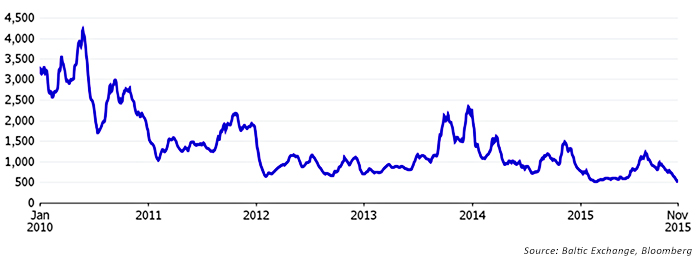
Said Bloomberg at the time, “The cost of shipping commodities fell to a record [low], amid signs that Chinese demand growth for iron ore and coal is slowing, hurting the industry’s biggest source of cargoes.”
FIGURE 1: COMMODITY SHIPPING INDEX FALLS TO RECORD LOW (BALTIC DRY INDEX)

Bloomberg added:
“Just as China’s surging imports of iron ore and other commodities led a surge in the Baltic Dry Index to a record in the last decade, now rates are sliding ever lower as that growth stalls. The nation’s ore purchases will expand by just 1 percent in 2016, about half this year’s expansion and the weakest pace in six years, according to data from Clarkson Plc, the world’s biggest shipbroker. Global trade in the raw material will increase the most slowly since 2001.
It’s not just a slowdown in iron ore that’s pressuring owners. Coal, the second biggest source of cargoes, is weakening too. Global trade in the fuel and steelmaking raw material will grow by 2 percent this year, Clarkson data show. China’s buying will slide 5.7 percent next year to 159.7 million metric tons.”
Flash forward to the present day and the global shipping metric has improved considerably compared to its bottom in February 2016 (more than doubling from lows just under 300 to Sept. 9’s 804). But it is well below the stratospheric highs of 2007–8 (above the 11,000 level just before the global financial crisis), and about 80% below 2010’s 4,000-plus mark.
FIGURE 2: BALTIC DRY INDEX (10-YEAR TREND)

Recently, as The Wall Street Journal observed, one of the world’s largest container-shipping companies, Hanjin Shipping Co., will likely be liquidated by the Korean government. According to the Journal, this may offer some short-term relief for shipping prices, but it “won’t likely solve the shipping industry’s biggest problem: 30% more space on ships than cargo to fill it amid a world-wide trading slump.”
According to a recent Goldman Sachs research note, as reported by Splash, “Dry bulk freight rates are set to remain low for the rest of this decade as overcapacity will haunt the sector.”
Why do economists pay close attention to the Baltic Dry Index? Not only does it provide insights on the health of world economies, many observers believe it is an early warning signal that has preceded almost all major global financial market meltdowns since the 1980s.
Says Business Insider of the BDI, “Analysts keen to predict … the health and future of the global economy like to pay close attention to it. It is frequently used as a so-called canary in the coal mine for the state of the world economy and how well international trade is doing. … This matters because BDI drops have historically predicted economic crashes. It did in 2008 and it did again last November when commodity and oil prices jumped off a cliff.”
Added The New Yorker in June 2016:
“Since the Baltic Dry Index débuted, in 1985, economists of all stripes have routinely consulted it as a trusted proxy for trade activity. … A decrease usually means that shipping prices and commodities sales are dropping (the latter because shippers are competing over fewer consignments). Shipping is a direct indicator of whether people want goods, and softness in shipping prices is therefore a sign of weakness in manufacturing and construction. … While the catastrophic scenarios offered by the pessimists aren’t quite plausible, the B.D.I.’s dramatic plunge does appear to have indicated a genuinely alarming economic trend about the strength of global trade, with implications for jobs and corporate profits.”
